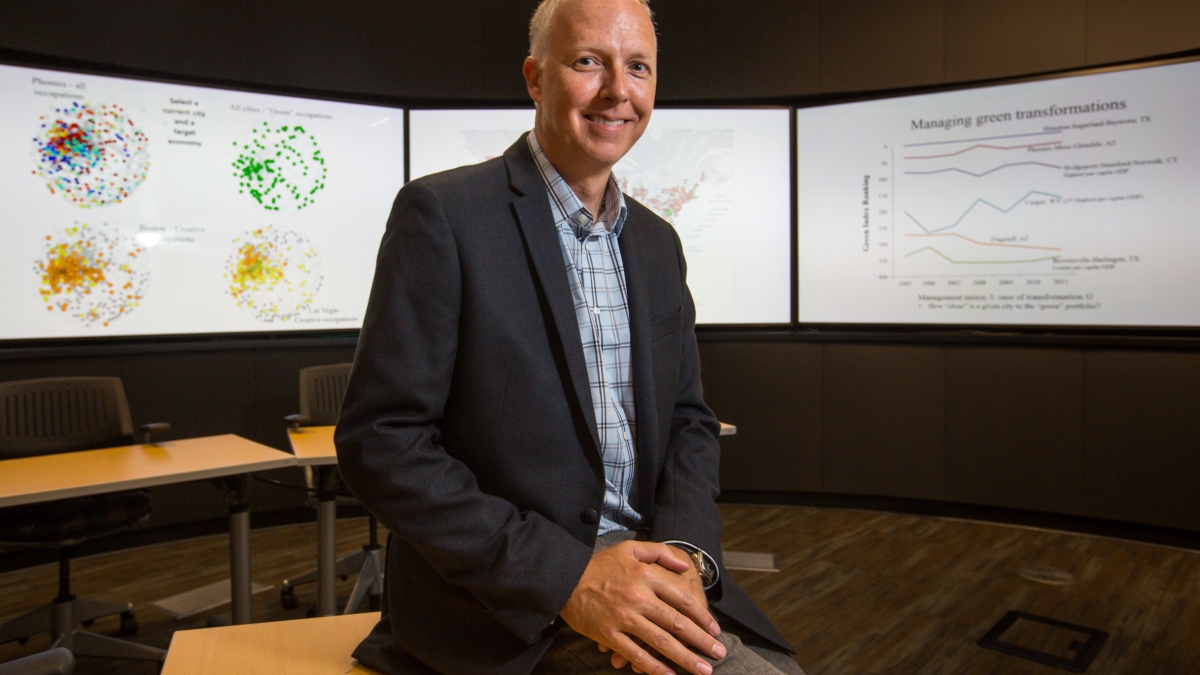The man with the power to predict economic success

Shade Shutters shows some of the economic analytics he has produced to assist communities in making development decisions, in the Decision Theater in Tempe on July 28. He is a research scientist in ASU’s Global Security Initiative.
There’s a mild disappointment when you meet Shade Shutters and listen to him discuss his area of study.
Because after you learn he’s a research scientist in ASU’s Global Security Initiative, you really want this man with the comforting demeanor and pleasant eyes to tell you he’s studying the impact of reducing solar gain on communities.
After all, his name is Shade Shutters.
Once you get past the absence of typecasting, all disappointment is washed away because what Shutters will tell you is much more interesting than the amusement of an obvious name game.
Like how this former international finance professional went back to school to get a doctorate in biology so he could better understand his field – more on that in a bit. Or how he has developed an algorithm that can divine which industries fit best in a particular city. He can even help a city determine whether it has the right makeup to become a creative or “green” economic hub.
Yes, in a sense, Shutters has created digital clairvoyance for the world’s civic economies.
This is how it works:
Say Happyland, Oklahoma – an actual town, by the way – believes it’s the perfect location for a pharmaceutical industry, but the city leaders want to consult Shutters just to be certain. He’ll collect the city’s metrics, then overlap the data associated with the pharmaceutical industry into his algorithm.
The results will tell him whether Happyland has the appropriate infrastructure, complementary businesses and whatnot to support the decision to woo a pharmaceutical company. It also examines economic impact, risk and other factors.
“So, if you want to shoot to a certain industry and invest some money and raise some bonds and create infrastructure, this is probably a better fit over here,” he says. “That’s the kind of thing they need to help them prioritize their growth strategy.”
If it doesn’t look like a match, Shutters can tell the smiley folks of Happyland which industries would fit best in their burgh. Or, conversely, he could show an industry leader which locale is best suited for their long-term success.
In some ways, this is oversimplifying the detail of Shutters’ methodology, which mines a mind-boggling amount of data that he refines and displays on multiple screens in ASU’s Decision Theater to visualize the overlapping data points. In a more abstract way, what he’s doing is looking at each city as an organism of sorts, how each of its different sectors and traits interact with incoming businesses.
And that’s where his biology background comes into play.
“Think of all the occupations in an urban economy as a network. How are they interlinked and intertwined? They make a web of labor,” says the native of Seymour, Indiana, the same town that birthed rock star John Mellencamp. “What we’re most interested in is what does the big web look like of all occupations?”
And to do that, sometimes it helps to view the city in the same way you view organisms, by looking at which industries work together and rely on each other to maintain the health of the overall ecosystem.
He calls the effect “tightness,” as in how bunched, or tight, a city’s connectivity between jobs and industries is. For instance, a city reliant on the health-care industry would like to have a “tight” network of jobs that complement each other.
And in studying the tightness of cities, Shutters discovered something rather interesting.
“The prevailing theory out there is that these really tight, integrated, highly interdependent systems are the most resilient. … And, instead, what I found was the opposite,” he says. “It’s those tightly wound cities that had a huge drop in economic performance during the recession.”
The little cities? They fared much better. He attributes it to the smaller cities being composed of industries that don’t rely on complementary parts to survive.
“Like a human body, if you get shot, it might only affect you right here (pointing to his shoulder), physically, but the person is probably going to die because the whole system collapses,” Shutters says. “Whereas you take an animal like the sponge, you can run them through a sieve and they re-form. They’re not tightly integrated like a human body.”
And that’s where the biological perspective helps his cause so well.
But though the methodology and implementation for his algorithm are very cool, it’s missing one key feature: a name.
So far, Shutters says he and the other co-creators, ASU’s Jose Lobo and former ASU Sustainability Scientist Rachata “Chot” Muneepeerakul, have been calling it “Urban Science Working Group.”
Not as unique or interesting as, say, Shade Shutters. But it’s still early. The theory of this project was presented just two years ago, with the practical applications being implemented only recently.
It’s going to grow and develop — just don’t expect it to languish in scholarly journals or live at academic conferences.
“I’m really interested in implementing change with decision makers,” Shutters says in his office. “I don’t want to just publish and move on.”